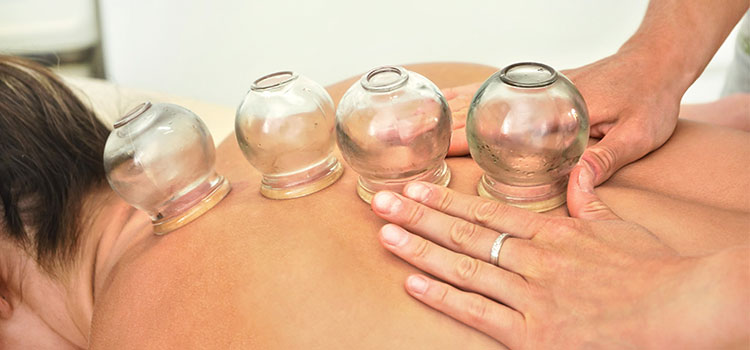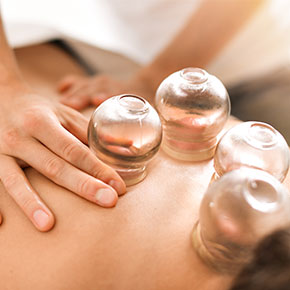Alternative, Massage & Holistic Articles You May Like
Cupping Therapy: Training, Tuition, and Salary Opportunities
Massage therapists specializing in cupping can bring comfort and healing to their patients, using a method that dates back thousands of years.


Written and Reported by Lisa Schuetz
Contributing Writer
Cupping therapy has become a trendy treatment sought by amateur and competitive athletes ever since record-setting U.S. swimmer Michael Phelps sported his circular bruises at the 2016 Olympics in Rio.
However, cupping isn’t new. It has been used for centuries by acupuncturists and natural healers, and dates back to ancient Egyptian, Chinese, and Middle Eastern cultures.
In This Article
What is Cupping?
Cupping is thought to improve blood flow, remove unhealthy toxins, reduce swelling, and create a sense of wellbeing in patients. Eastern medicine practitioners believe that cupping facilitates the flow of qi—or life force—in the body.
Cupping practitioners can use two methodologies: wet cupping and dry cupping.
When treating a client using cupping, a licensed practitioner—typically a massage therapist or acupuncturist—uses alcohol or another flammable substance to create a fire inside several round glass, earthenware, bamboo, or silicone “cups.”
After the fire goes out, the cups are turned over and placed on the client’s skin. The cups are left in place to cool for about three minutes. The cooling creates suction, and often a subsequent bruise. Some practitioners use a rubber pump instead of fire and cups to create the suction effect.
Cupping creates negative pressure to manipulate soft tissue, deal with scar tissue and adhesions, and increase blood flow.
This process is considered “dry” cupping. Another approach takes the process a step further. “Wet” cupping involves the use of a small scalpel to make light, tiny cuts in the client’s skin after the cups are removed. A second suction is performed to draw out a small quantity of blood.
Who’s a Good Candidate for Cupping?
Cupping isn’t limited to athletes looking to improve their game. Massage therapists use this type of manual therapy on any client looking to recover from an injury, feel better after an illness, and improve range of motion.
“You will see cupping used by physical therapists, massage therapists, acupuncturists, even occupational therapists,” says Lisa McNeil, a massage health professional practicing in Sussex, Wisconsin, and medical team member for the 2020 Olympics.
Cupping is “a great way to manipulate fascia and layers of connective tissue. Used dynamically, it increases range of motion with less effort from the therapist. Used statically, it can help with releasing scar tissue and help with adhesions.”
Cupping can help release scar tissue and adhesions with less effort from the therapist.
What Type of Training Do I Need?
Those interested in administering cupping therapy will first need to be licensed, most commonly as a massage therapy provider. Cupping therapy is often introduced in basic massage therapy classes, says McNeil, but adding the specialty therapy to your toolkit will mean taking more continuing education courses, available both online and in person.
There are also varying degrees of cupping therapy education, depending on how you want to use it and the level of expertise you’d like to achieve. Some classes focus on cupping for medical treatment, while others focus on cupping as a tool for a relaxation massage.
Do I Need to Be Certified?

As with most massage specialties, a certification is not required. You don’t need a specific cupping certification to practice, but earning one can demonstrate your mastery of the subject to your clients. It can also help ensure you are administering the modality correctly and effectively. Many schools and programs offer courses and workshops in cupping therapy.
While a specialty certification is not mandated, a license to put your hands on a client is (in nearly all states). If you are already a licensed massage therapist, licensed acupuncturist, or other type of licensed provider, you’re likely covered. Requirements vary by state, however. Contact your state’s professional board, association, or organization to determine if they regulate massage specialties before practicing.
You may also want to look into liability insurance since cupping involves the use of tools beyond simply your hands.
Average Length of Study
Continuing education classes in cupping typically include at least three hours of education covering several topics. Instruction can take place over one long day or several days, depending on the institution.
If you are looking for certification from a specialized school, then your training may take two days or more of in-person learning with up to 20 hours of practice with clients. Be sure to confirm that the school you are attending is properly accredited.
What Does It Cost?
The cost of certification will depend on the level of training you pursue. Continuing education classes—both online and in person—can range from $120 for a short course to just over $800 for a more comprehensive course that includes certification.
Of course, any certification or continuing education classes focusing on cupping will require prior completion of a basic massage therapy or similar program. Tuition for massage therapy schools also varies, depending on length and types of classes offered.
Salary Opportunities
While the U.S. Bureau of Labor Statistics doesn’t specifically cite the salaries of cupping therapy specialists, they do track average salaries for massage therapists. According to the BLS, massage therapists across the country earn a median annual salary of $55,310.
This number can vary widely and can depend on how many hours you work; how much you pay to rent an office, clinic or studio; and a number of other factors. Many therapists work part-time (averaging about 27 hours a week) and, if self-employed, don’t get paid for the non-massage activities involved in running a practice.
Career Outlook
According to the BLS, massage therapist careers will grow faster than most jobs, at a rate of about 18.3% through 2031. The public’s increasing belief that holistic wellness, massage, and Eastern therapy practices are methods that support longevity and health are behind the growth in massage therapy jobs over the next decade.
Massage Therapist Job Growth Through 2031
18.3%
much faster than average for all careers says the BLS
McNeil advises that students should plan to use cupping therapy as an additional modality in a massage practice rather than as a sole focus, which is what she does.
With professional insight from:
Lisa McNeil
Massage health professional
